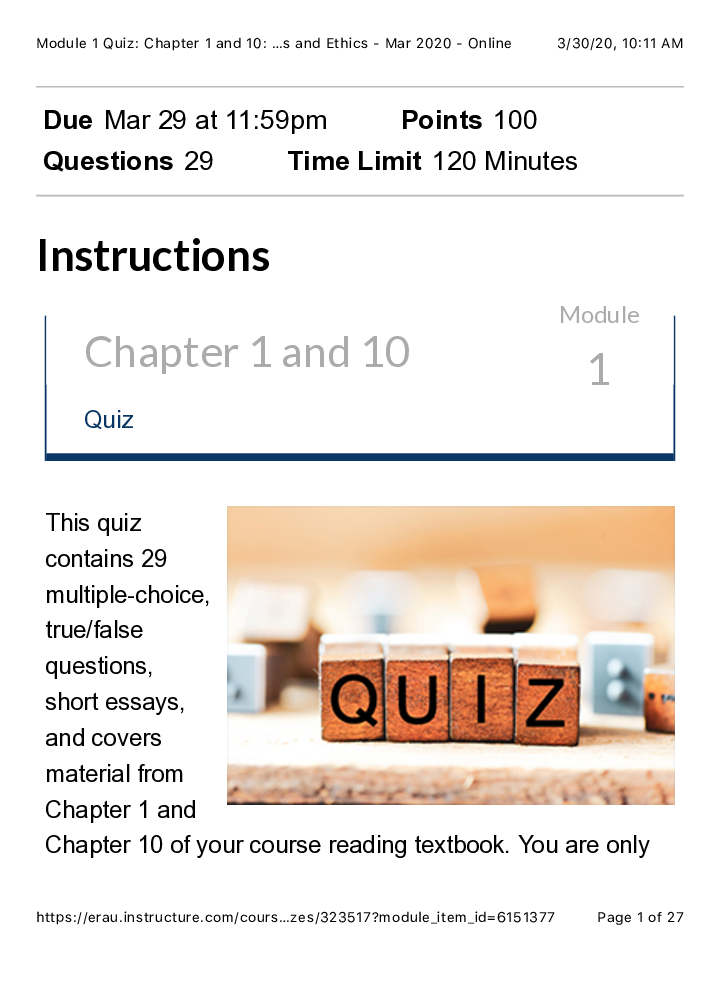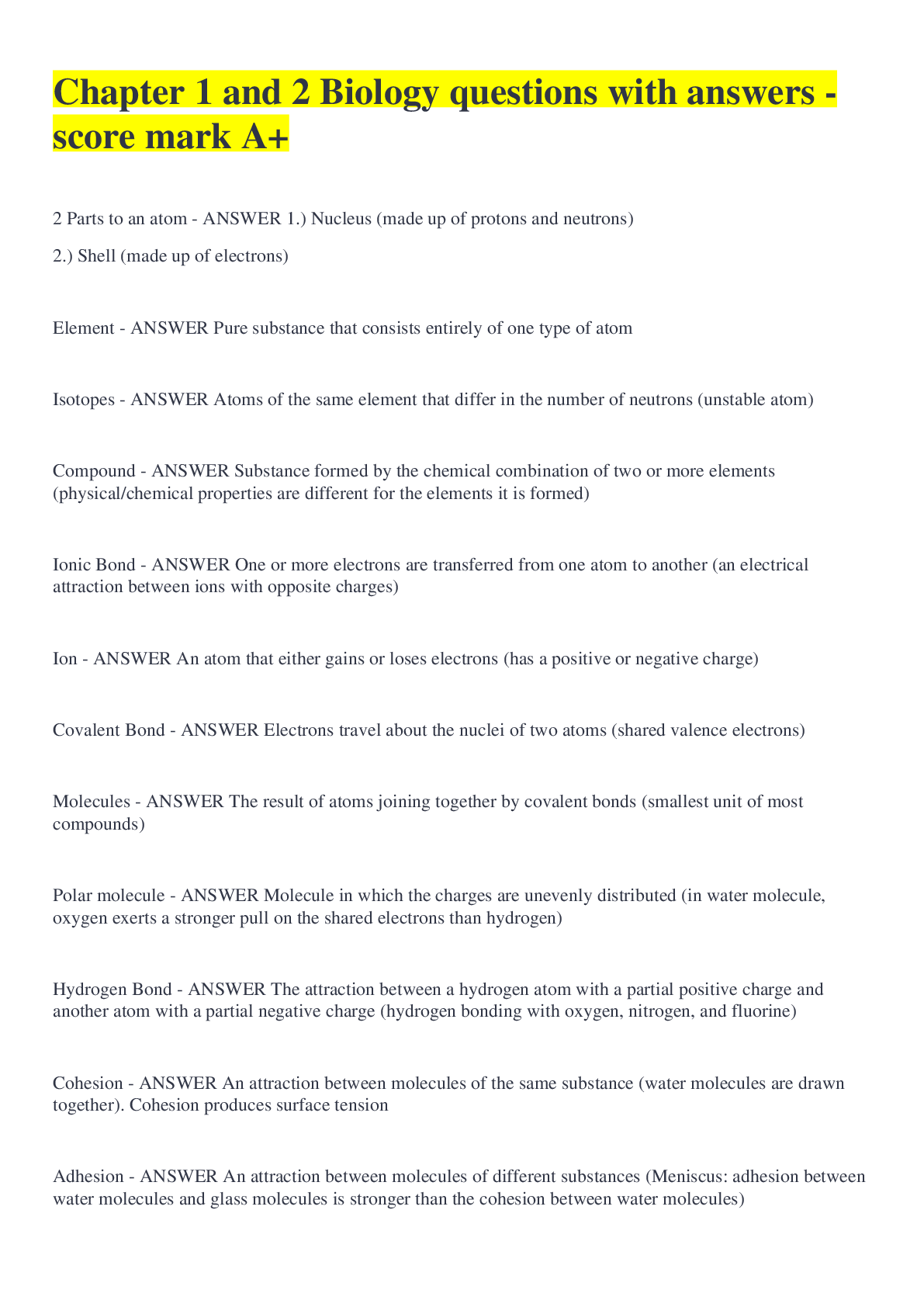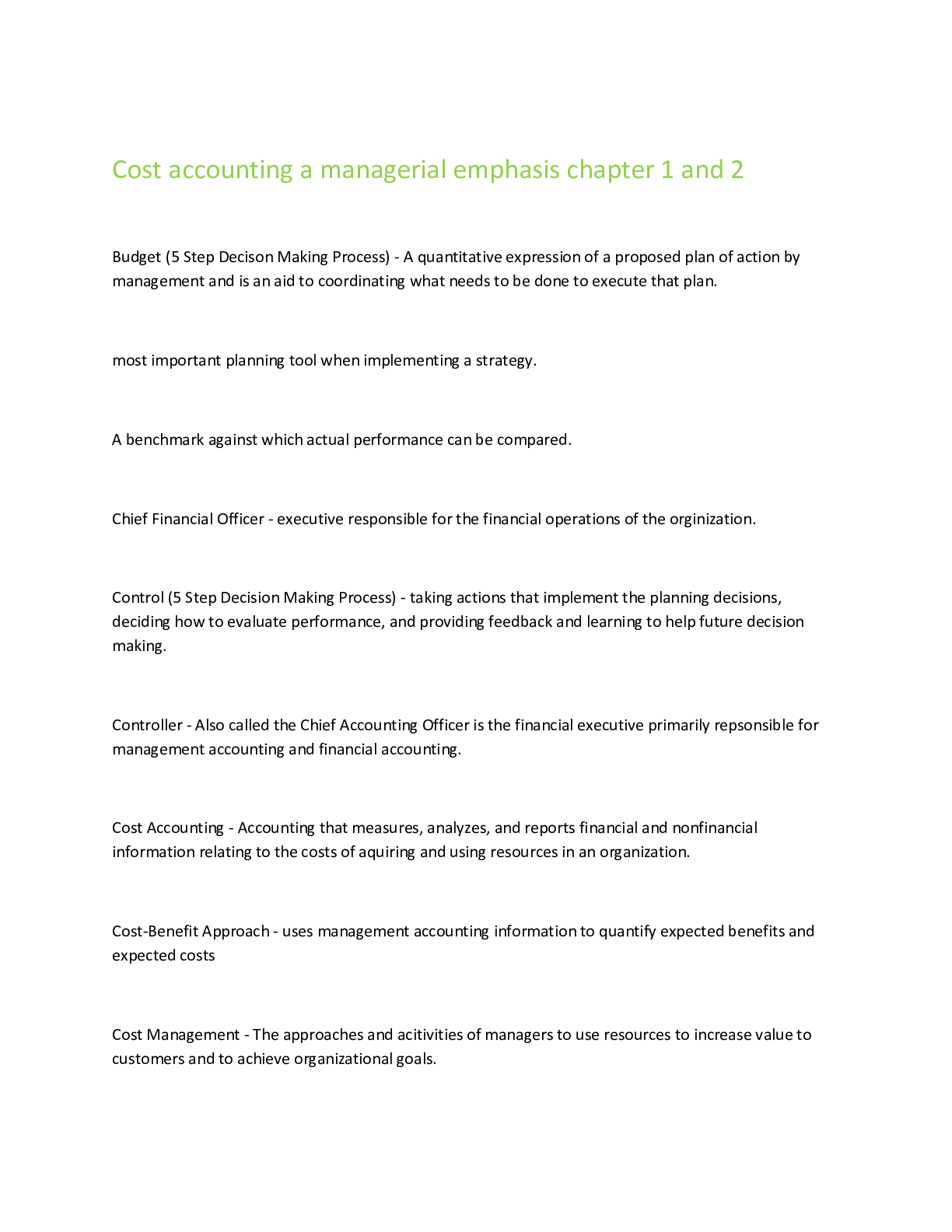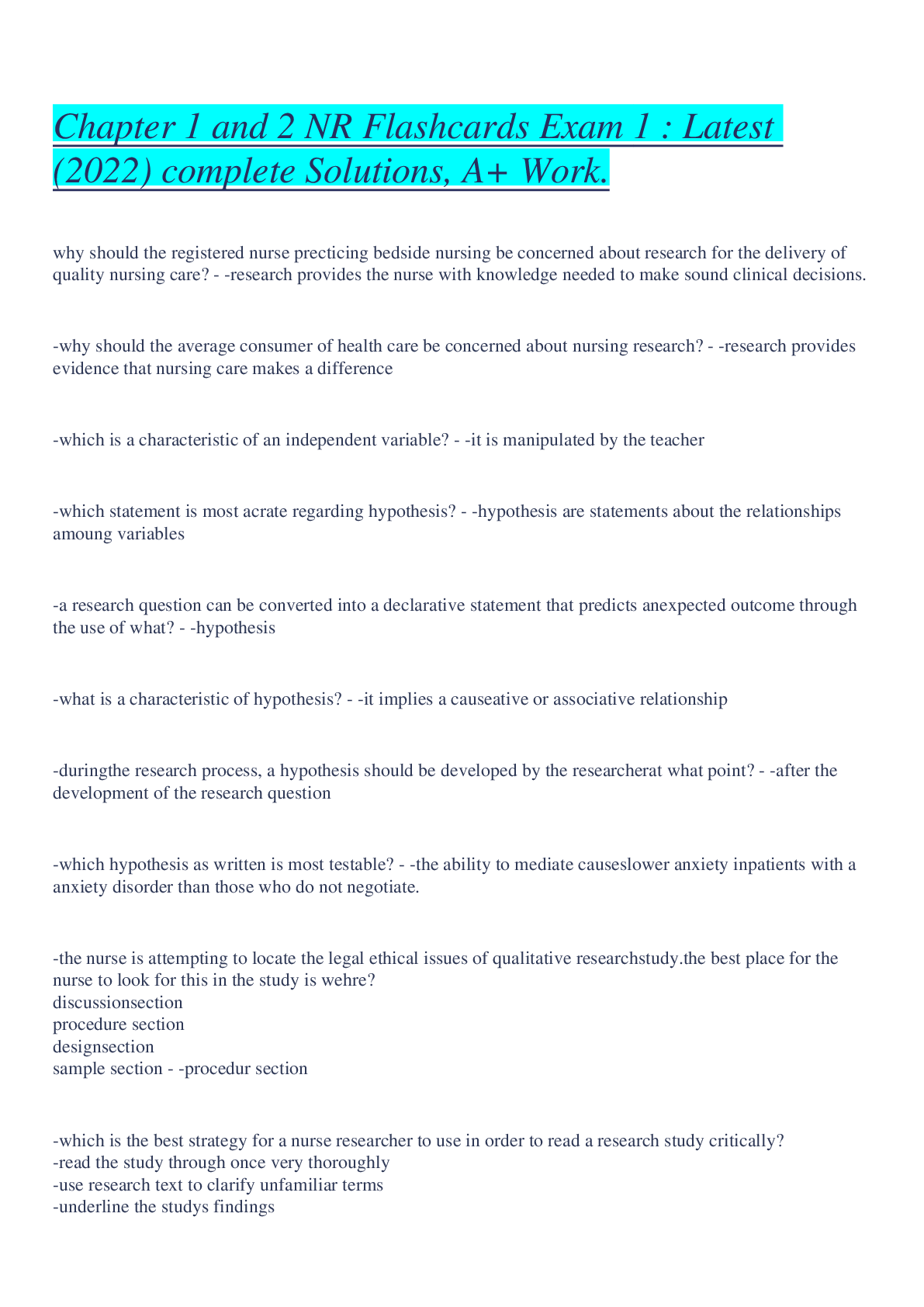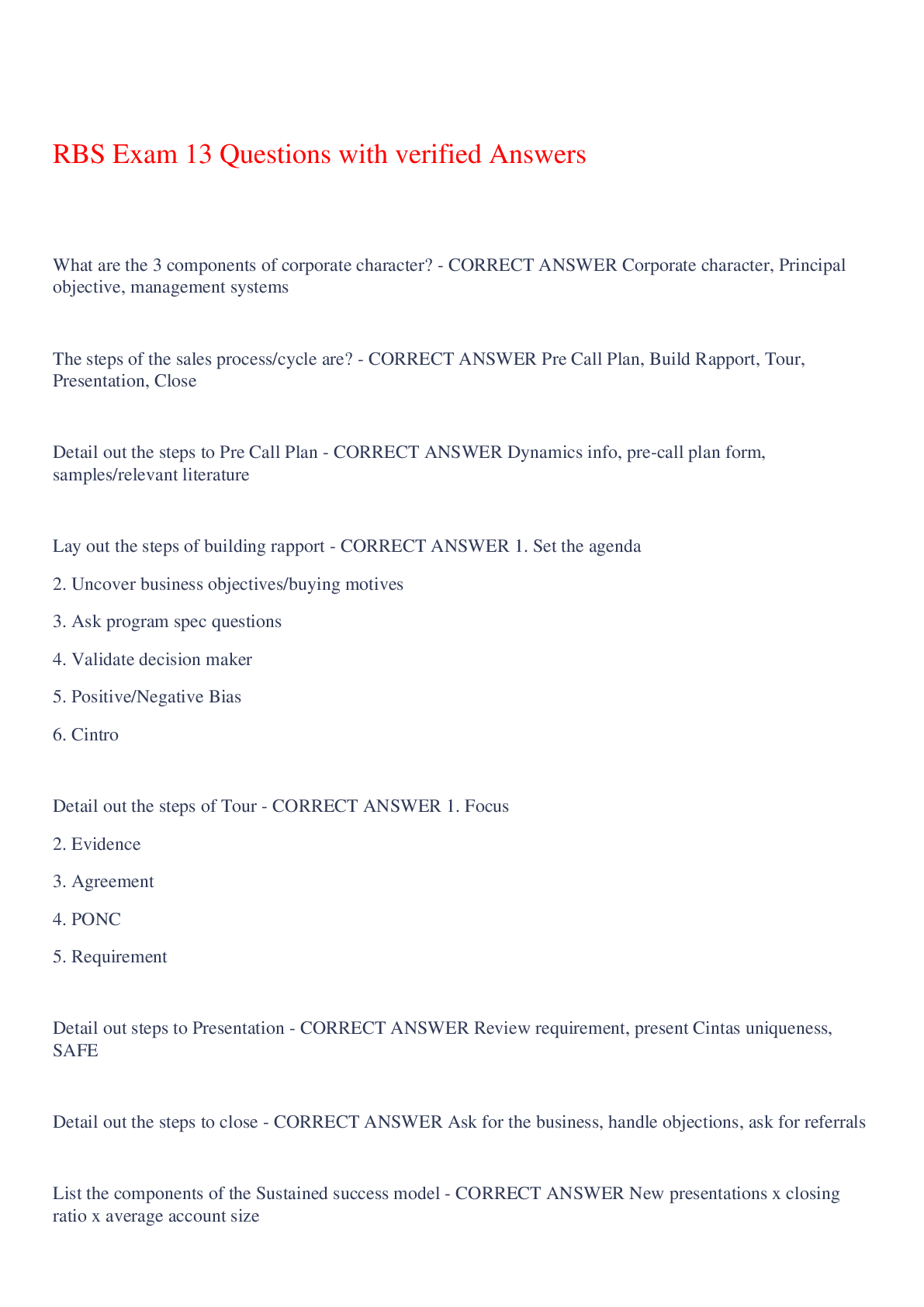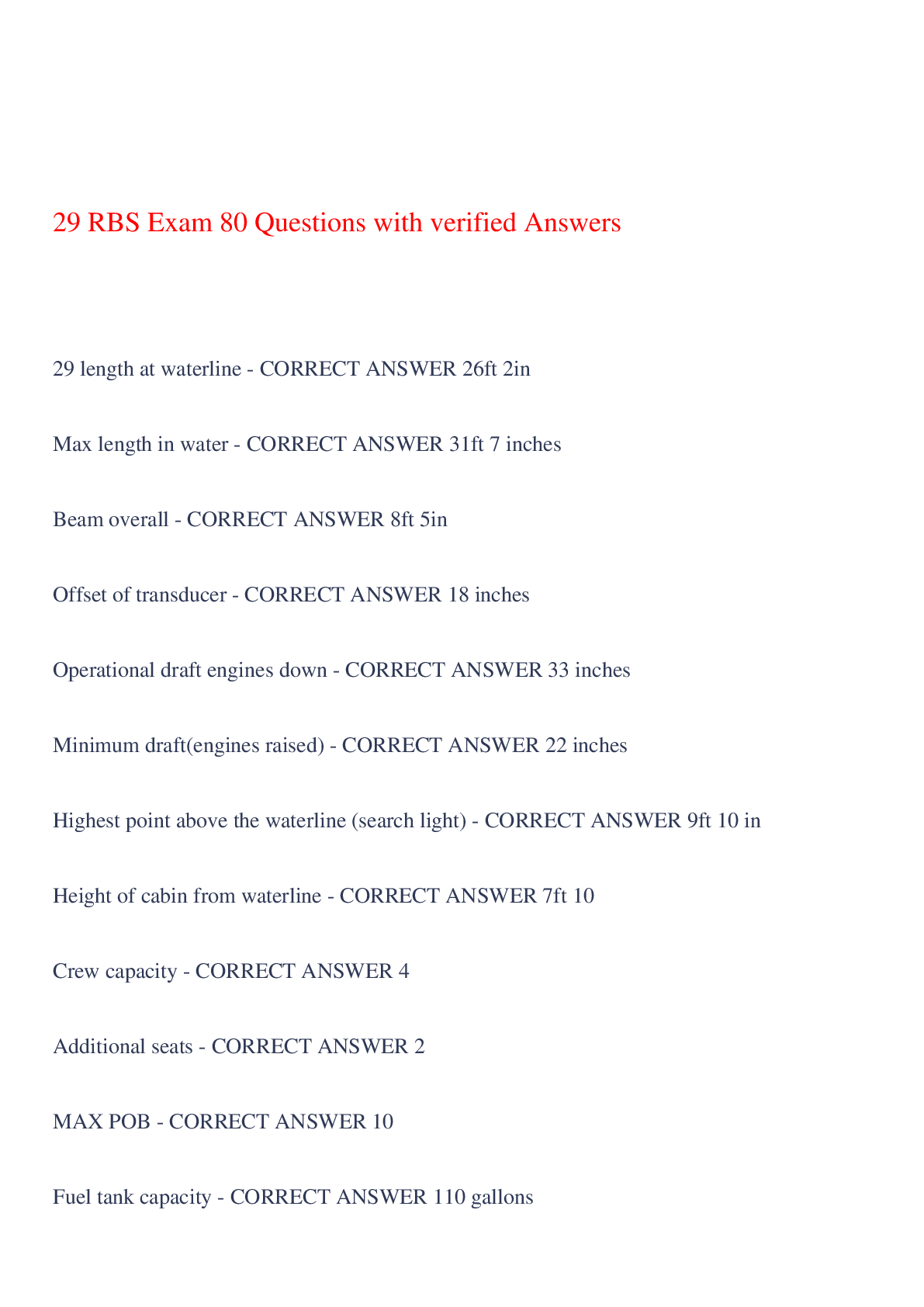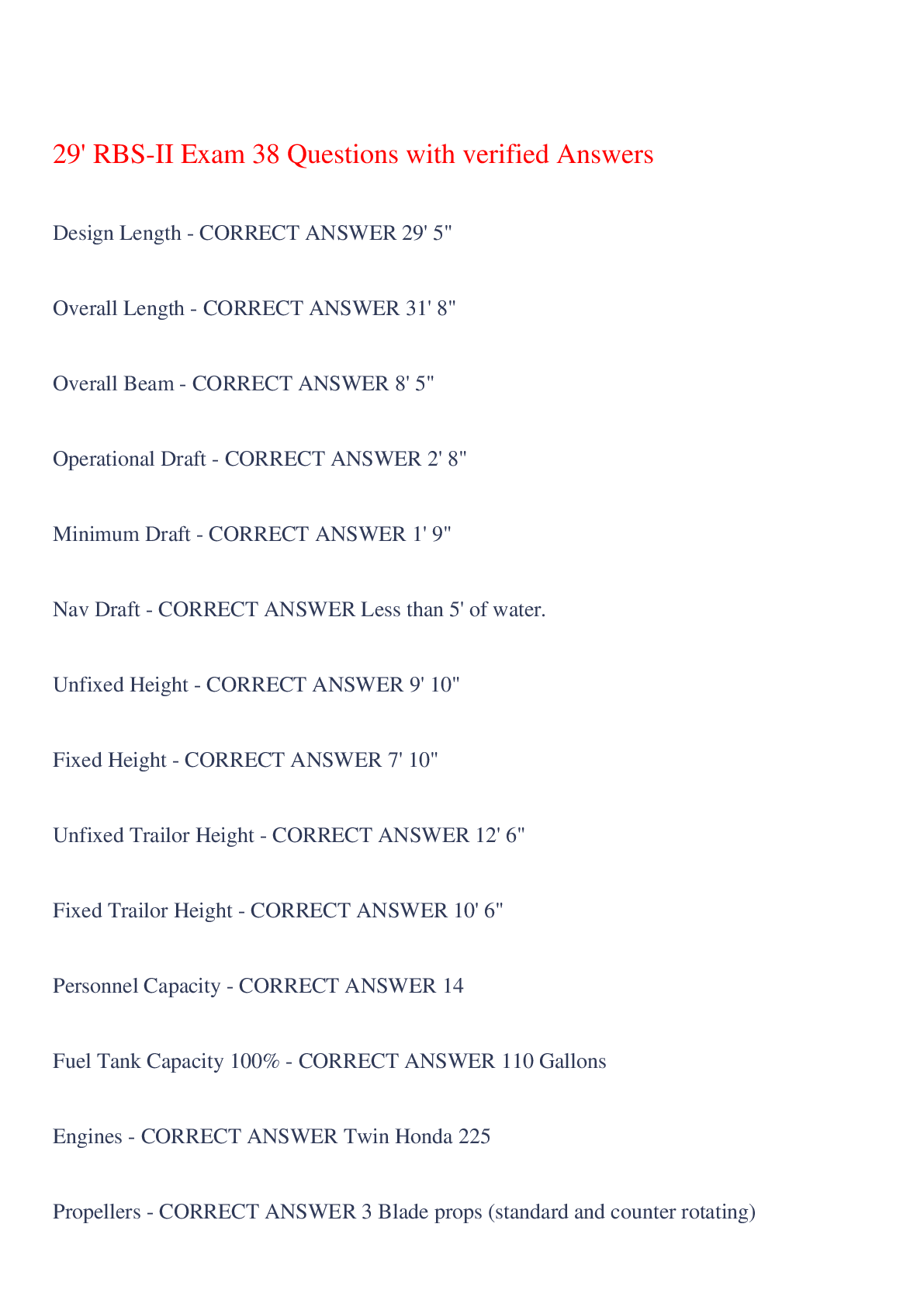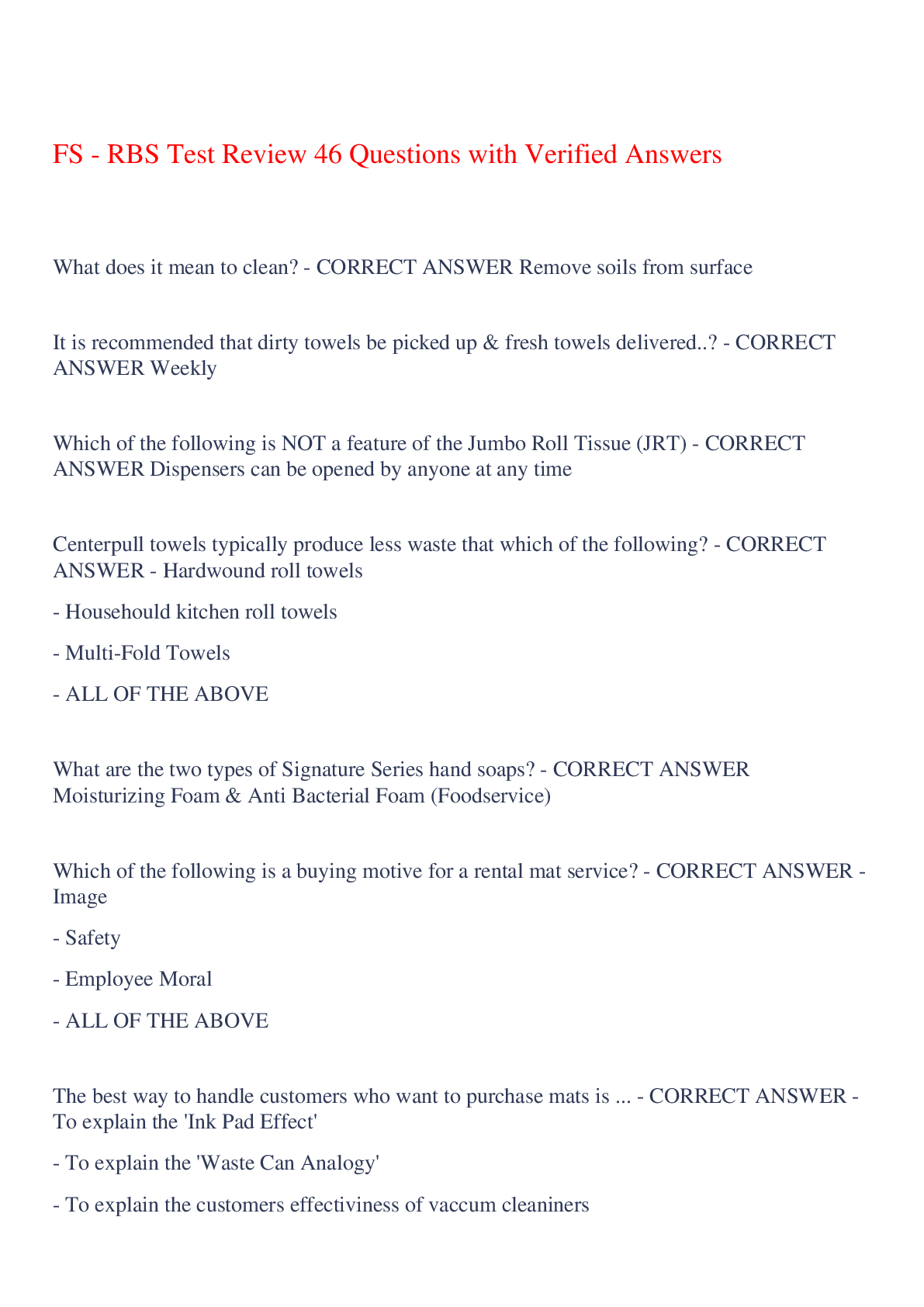*NURSING > EXAM > EDF 6225 Chapter 1 and 2 (For test #1) 111 Questions with Verified Answers,100% CORRECT (All)
EDF 6225 Chapter 1 and 2 (For test #1) 111 Questions with Verified Answers,100% CORRECT
Document Content and Description Below
EDF 6225 Chapter 1 and 2 (For test #1) 111 Questions with Verified Answers Applied Behavior Analysis: The science in which tactics derived from the principles of _________ are applied to improve __... ______ significant behavior and experimentation is used to identify the variables responsible for behavior change. - CORRECT ANSWER behavior socially ________________: The idea that the universe is a lawful and orderly place in which all phenomena occur as a result of other events, or are systematically related to other factors, which are themselves physical phenomena amendable to scientific investigation. - CORRECT ANSWER Determinism Behaviorism: The ___________ of the science of behavior. The science of behavior entails 3 domains: philosophy, basic research (______) and applied research (ABA). - CORRECT ANSWER philosophy EAB ______________: a controlled comparison of some measure of the phenomena of interest (__________ variable) under two or more different conditions, in which only one factor at a time (independent variable) differs from one condition to another. - CORRECT ANSWER Experiment dependent Empiricism: the practice of ____________ observation of the phenomena of interest, independent of the individual prejudices, tastes and private opinions of the scientist. - CORRECT ANSWER objective Experimental Analysis of Behavior (EAB): _________ research; named by Skinner to be the analysis of operant behavior. - CORRECT ANSWER Basic ___________ Fiction: a fictitious or hypothetical variable that often takes form of another name for the observed phenomenon it claims to explain and contributes nothing to a functional account or understanding of the phenomenon, such as "intelligence" or "cognitive awareness" as explanations for why an organism pushes the lever when the light is on and food is available but does not push the lever when the light is off and no food is available. - CORRECT ANSWER Explanatory Hypothetic Constructs - CORRECT ANSWER Presumed but unobserved entities that cannot be manipulated in an experiment, such as cognitive processes, drives and free will. Functional Analysis: a demonstration of functional ________ between environmental variables and behavior. This differs from a correlation. A correlation means that we see two things sometimes _________ with each other, such as vocabulary knowledge and shoe size. However, shoe size does not determine vocabulary knowledge, and therefore those two variables do not have a function relation. A functional relation indicates as one variable changes in one way, the other variable reliably changes as well. A functional relation exists when we well controlled experiment demonstrates a specific change in one event is _________ produced by manipulations of another event, and the change is unlikely to be due to other cofounding variables. - CORRECT ANSWER relations covary reliably _____________: An approach to explaining behavior that assumes that a mental, or "inner," dimension exists that differs from a behavioral dimension and that phenomena in this dimension either directly cause or at least mediate some forms of behavior, if not all. Hypothetical constructs and explanatory fictions make up mentalism, and this idea dominated intellectual thought in most early psychological theories (Ex Freud). - CORRECT ANSWER Mentalism ________________ Behaviorism: Philosophical position that considers behavioral events that cannot be publicly observed (inner variables such as feelings) to be outside the realm of the science. This standpoint views everything in the mind as inside the "black box" and therefore believes it the be outside the realm of science. - CORRECT ANSWER Methodological _____________: Requires that all simple, logical explanations for the phenomena of interest be ruled out experimentally before more complex or abstract explanations are considered. - CORRECT ANSWER Parsimony Philosophic Doubt: Requires the scientist to continually __________ the truthfulness of what is regarded as fact. Example: could there be another reason for why this behavior is occurring? (Ex: molars are coming in, biting feels good because of the pressure). - CORRECT ANSWER question Pragmatism: A philosophical position asserting that the truth value of a statement is determined by how well it promotes effective action; pragmatism is a primary criterion by which behavior analysts judge the __________ of their findings. - CORRECT ANSWER value __________ Behaviorism: B.F. Skinner's philosophy of the science of human behavior. Most influential type of behaviorism for guiding the science and practice of behavior analysis. Wanting to understand ALL behavior, he incorporated private events into an overall conceptual system of behavior. - CORRECT ANSWER Radical Replication: Repeating of experiments or ________ within an experiment. - CORRECT ANSWER trials Science: a systematic approach to the understanding of natural phenomena that relies on ___________ as its fundamental assumption, Empiricism as its primary rule, Experimentation as its basic strategy, Replication as a requirement for believability, Parsimony as a value, and ____________ doubt as its guiding conscience. - CORRECT ANSWER Determinism Philosophic 3 types of scientific understanding: _____________, Prediction and Control. (control is highest level). - CORRECT ANSWER Description Systematic _________________ and Descriptive Knowledge: (level of scientific understanding: DESCRIPTION). Systematic observation enhances the understanding of a given phenomenon by enabling scientists to describe it accurately. Descriptive knowledge/Descriptive studies consists of a collection of facts about the observed events that can be quantified, classified and examined for possible relations with other known facts. Example: she twirls her hair when she is on the bus and does not twirl her hair when she is at recess. - CORRECT ANSWER Observation Correlation: (level of scientific understanding: PREDICTION) When repeated observations reveal that two events consistently ____________ with each other. (not causal). Example: very often, she twirls her hair when she is given a task. - CORRECT ANSWER covary Functional Relation: (level of scientific understanding: _______________) When a well-controlled experiment demonstrates that a specific change in on event (dependent variable) is reliably produced by specific manipulations of another event (independent variable) and that the change in the dependent variable was unlikely to be the result of other cofounding variables. Example: We could give the client more tasks to see if the hair twirling behavior increases, and then remove tasks to see if the hair twirling decreases. If the data continues to follow this pattern, we can now say we have control of the behavior. - CORRECT ANSWER CONTROL The attitudes of science: determinism, _____________, experimentation, replication, ____________ and philosophic doubt. Scientific knowledge is built on, above all- empiricism. - CORRECT ANSWER empiricism parsimony Every effort to understand, predict and improve behavior hinges on the behavior analyst's ability to........ A) completely _________ B) systematically __________ and C) accurately and reliably __________ ...occurrences and non occurrences of when the events are observed to covary. - CORRECT ANSWER define observe measure Experiments that have demonstrated or discovered a functional relation between a target behavior and one or more environmental variables are said to have achieved a.... - CORRECT ANSWER Functional analysis What is the primary method in which scientists determine the reliability and usefulness of their findings and discover mistakes? - CORRECT ANSWER Replication The attitude of parsimony is sometimes called the... - CORRECT ANSWER Law of Parsimony- derived from Ocaam's Razor. 3 domains of the science of behavior analysis - CORRECT ANSWER A) philosophy (behaviorism) B) basic research (experimental analysis of behavior) C) applied research (applied behavior analysis) Name Skinner's 3 initial books - CORRECT ANSWER "The Behavior of Organisms" (1938) "Walden Two" (1940's) "Science and human behavior" (1953) Describe the psychology of the early 1900's - CORRECT ANSWER -dominated by the study of states of consciousness, images and mental processes. (Freud) -Introspection was a primary method of investigation -lack of scientific method John B. Watson - CORRECT ANSWER "Psychology as the behaviorist views it". -argued that the subject matter of psychology was behavior -argued that behavior is the relationship between environmental stimuli (S) and responses (R). Watsonian Behaviorism is known as S-R psychology. Quote: "give me a dozen healthy infants..." The experimental branch of ABA formally began with the publication of... - CORRECT ANSWER Skinner's "Behavior of Organisms" Respondent Behavior - CORRECT ANSWER reflexive behavior, as in the case of Pavlov. Respondents are Brough out by stimuli that immediately precede them (antecedents). The antecedent stimulus and response it elicits form a functional unit called a REFLEX. Respondent behaviors are essentially involuntary , and occur whenever the eliciting stimulus is presented. Operant Behavior - CORRECT ANSWER not elicited by preceding stimuli but instead are influenced by stimulus changes (consequences) that have followed the behavior in the past. (These behaviors are emitted). Skinner's Radical Behaviorism states 3 major assumptions on the nature of private events - CORRECT ANSWER 1) private events such as thoughts and feelings are behavior 2) behavior that takes place within the skin is distinguished from other public behavior only by its inaccessibility 3) private behavior is influenced by or is a function of the same kind of variables as publicly accessible behavior. The first study to report the human application of principles of operant behavior... - CORRECT ANSWER Fuller (1949) Research on an 18 year-old boy with developmental difficulties The branch of behavioral analysis that would later be called Applied Behavior Analysis can be traced back to the 1959 publication of.... - CORRECT ANSWER Ayllon and Michael's paper... "The Psychiatric Nurse as a Behavioral Engineer." What two events in 1968 marked that year as the formal beginning of contemporary ABA? - CORRECT ANSWER 1) JABA (Journal of Applied Behavior Analysis) 2) publication of the paper "Some Current Dimensions of Applied Behavior Analysis" by Beyer, Wolf and Risley.(Founding fathers of the new discipline). What are the 7 dimensions of ABA (as described by Beyer, Wolf and Risley)? - CORRECT ANSWER GETACAB generality effective technological applied conceptually systematic analytic behavioral Describe the 7 dimensions of ABA and their meanings. - CORRECT ANSWER Generality: behavior change that lasts over time Effective: produces behavior changes that reach clinical or social significance. Technological: operative procedures are clearly defined Applied: selected behaviors are those that are socially and significantly important to the CLIENT Conceptually systematic: procedures for changing behavior must be derived from relevant principles of behavior Analytic: when the experiment has demonstrated a function relation between manipulated events and reliable change in some dimension of targeted behavior Behavioral: studying the behavior of the client, noting WHOSE behavior changed What is the 3-term contingency, and name the possible functions of behavior. - CORRECT ANSWER ABC (Antecedent, Behavior, Consequence. (S-R-S Model). SEAT.... Sensory (automatic) Escape Attention Tangible (access) Describe Overt and Covert behaviors. - CORRECT ANSWER overt: external behaviors covert: behaviors we cannot see (such as feelings). What are some promises/possibilities of ABA, and what are some areas that we could grow in? - CORRECT ANSWER Promises/Possibilities: effective/lasting change, scientific approach Needed Growth: including clients in every aspect of planning, and combating ableism When a systematic covariation occurs between two events, we are able to predict the probability that one event will occur in conjunction with the other event. This is called a.... - CORRECT ANSWER correlation Describe the independent variable versus the dependent variable. - CORRECT ANSWER Independent variable: event that we manipulate (the intervention) Dependent variable: event in which we observe change (the behavior) The _______ is the natural science approach for discovering orderly and reliable relations between behavior and various types of environmental variables of which is the function. - CORRECT ANSWER Experimental analysis of behavior (EAB) ________ was established by Baer, Wolf and Risley with the 7 guiding dimensions. - CORRECT ANSWER Applied Behavior Analysis The Behavior Analyst Certification Board (BACB) - CORRECT ANSWER the national governing board for professionals in the field of applied behavior analysis. Established in 1998. ABA if based off of... - CORRECT ANSWER B.F. Skinner's science The ________________ chart is the only standardized form of data measurement in our science. - CORRECT ANSWER Standard Celeration Chart (Dr. Lindsley helped with this) SAFMEDS - CORRECT ANSWER Say All Fast Minute Each Day Shuffled -Dr. Ogden Lindsley, 1980 Antecedent - CORRECT ANSWER refers to the environmental condition or stimulus changes that exist or occur prior to the behavior of interest. Automatic Reinforcement - CORRECT ANSWER Refers to the hypothesis that a (AKA self-stimming) behavior itself is reinforcing and is not dependent on social interaction or receiving a tangible item. (Ex scratching an itch). When an experimental analysis fails to identify the reinforcers maintaining the problem behavior, some for of automatic reinforcement is assumed. automaticity of reinforcement - CORRECT ANSWER Refers to the fact that behavior is modified by its consequences regardless of the person's awareness; a person does not have to recognize or verbalize the relation between her behavior and a reinforcing consequence, or even know that a consequence has occurred, for reinforcement to "work." aversive stimulus - CORRECT ANSWER a stimulus that is unpleasant (stimulus conditions whose termination functions as reinforcement). Ex) Loud, annoying noise. behavior - CORRECT ANSWER an organism's interaction with its environment that involves movement of some part of the organism. conditioned reinforcer or conditioned punisher - CORRECT ANSWER stimuli that are present with with the occurrence of other reinforcers or punishers may acquire the ability to reinforce or punish. (Ex: In the case of little Albert, we could use the conditioned rat as a punisher. behavior change tactic - CORRECT ANSWER a consistent method for changing behavior derived from one or more principles of behavior that possess generality across subjects, setting, or behaviors. Ex) backwards chaining, differential reinforcement of other behavior, shaping, response cost, etc. Conditioned reflex - CORRECT ANSWER a conditioned stimulus creates a conditioned reflex. (Ex: CRYING at the rat because the rat was paired with a loud, scary noise. Conditioned stimulus - CORRECT ANSWER a stimulus that was previously neutral was paired with a natural, unconditioned stimulus. Ex) loud, scary noise (US) was paired with rat (NS). Now the rat is the CS. consequence - CORRECT ANSWER a stimulus change that follows a behavior of interest. Some consequences have significant influence of future behavior. contingency - CORRECT ANSWER 3-term. ABC or S-R-S. When a reinforcer is said to be contingent on a particular behavior, the behavior must be emitted for the consequence to occur. To make the reinforcement contingent means delivering the reinforcer only after the target behavior has been emitted. Ex) Me: "Name a dinosaur." Client: "T-Rex." Me: "Great job!" -The "great job!" depends on the students response, "T-rex," contingency-shaped behavior - CORRECT ANSWER behavior that is acquired as a result of direct experience with contingencies. This ties into SHAPING: a new behavior is gradually acquired through reinforcement of successive approximations to a final form. deprivation & satiation (Motivating Operations) - CORRECT ANSWER The important qualification that the momentary effectiveness of the unconditioned reinforcer. Deprivation: Ex) not having eaten in a while may make a snack a strong reinforcer. Satiation: Ex) having just eaten a big meal may make a snack a weak reinforcer. discriminated operant - CORRECT ANSWER a behavior that occurs more frequently under some antecedent conditions than it does in others. When a discriminated operant (behavior) occurs more often in the present of a given stimulus that it does in the absence of that stimulus, it is said to be under Stimulus Control. Answering the phone is a discriminative operant. The phone ringing functions as the discriminative stimulus (SD) for answering the phone. (We answer the phone when it rings, not when its silent.) environment - CORRECT ANSWER refers to the full set of physical circumstances in which the organism exists. habituation - CORRECT ANSWER if the eliciting stimulus is presented repeated over a short span of time, the strength or magnitude of that response will diminish, and in some cases the response may not occur at all. This is the process of gradually diminishing response strength. (Ex: wind blows in your eye and wakes you blink, eventually you may blink less or not at all.) higher order conditioning (secondary conditioning) - CORRECT ANSWER conditioned reflexes can also be established by pairing of a neutral stimulus and the conditioned stimulus. For example, secondary respondent conditioning could occur in a patient who has learned to blink (CR) at the clicking sound of a button (CS) during eye exam testing. The patient detects a slight movement in the doctors finger (NS) just before it contacts the button to make the clicking sound. After several neutral stimulus- conditioned stimulus pairings, the movements of the doctors finger may become a conditioned stimulus capable of eliciting the blinking as well. history of reinforcement - CORRECT ANSWER All of a person's learning experience, especially past conditioning with respect to specific response classes or aspects of a person's repertoire. The repertoire of behaviors a person brings to any situation has been selected, shaped and maintained bother unique history of reinforcement. Joint control - CORRECT ANSWER A phenomenon in which two separate, but interrelated forms of a person's own verbal behavior, combine to acquire stimulus control of a response that would not have occurred in the absence of either. (Ex: Girl studying, repeating book title to herself, finding that book title in her room according to its matching her verbal behavior. positive punishment - CORRECT ANSWER adding something to the environment that decreases that behavior in the future. Ex) adding chores on to-do list. Negative punishment - CORRECT ANSWER removing something from the environment, and decreasing that behavior in the future (response cost). Ex) removal of tokens positive reinforcement - CORRECT ANSWER a response followed immediately by the presentation of a stimulus tat result in similar responses occurring more often. negative reinforcement - CORRECT ANSWER when a behavior occurs more often because past responses have resulted in the withdrawal or termination of a stimulus. Negative reinforcement is characterized by escape or avoidance contingencies, for example jumping out of the shower when the water suddenly turns too hot. Neutral stimulus - CORRECT ANSWER a stimulus that means nothing to us. An example would be Pavlov's metronome. Ontogeny - CORRECT ANSWER the selection of consequent during the lifetime of the individual organism and is a conceptual parallel to Darwins nature selection. operant behavior - CORRECT ANSWER any behavior determined primarily by its history of consequences, unlike respondent behavior, which is elicited by its antecedent events. operant conditioning - CORRECT ANSWER refers to the process and selective effects of consequences on behavior from an operant conditioning perspire. functional consequences - CORRECT ANSWER is a stimulus change that follows a given response closely in time and alters the occurrence o similar responses in the future. Phylogeny - CORRECT ANSWER a phylogenetic tree is a branching diagram showing the evolutionary relationships among various biological species. principle of behavior - CORRECT ANSWER describes a functional relation between behavior and one or more of it's controlling variables with generality across individual organisms, species, settings behavior and time. In the form y=F(x) punishment - CORRECT ANSWER when an operant conditioning consists of a decrease in response rate or similar responses occurring less often, punishment has taken place. reflexes - CORRECT ANSWER ready-made behaviors to protect against harmful stimuli and promote reproduction, and are part of our genetic endowment due to evolution. Reinforcement - CORRECT ANSWER when a response followed by a stimulus change that results in similar responses occurring more often in the future. repertoire - CORRECT ANSWER used to refer to all the behaviors a person can do or a persons collective knowledge and skills relevant to a particular setting or task. For example, each of us has a repertoire of behaviors appropriate for informal social setting that differ from formal social settings. respondent behavior - CORRECT ANSWER behavior that is elicited by antecedent stimuli. The response component of the stimulus-response reflex is called Respondent behavior. Respondent behavior is induced or Brough out by a stimulus that precedes the behavior, for example, bright light in the eyes will elicit pupil contraction. Respondent conditioning is called Pavlonian conditioning or Classical conditioning, which is where a formerly neutral stimulus can acquire the ability to elicit respondents through a learning process. Respondent Extinction - CORRECT ANSWER the procedure of repeatedly presenting a conditioned stimulus without the unconditioned stimulus until the conditioned stimulus no longer elicits the conditioned response. response - CORRECT ANSWER an action of an organisms effector. An effector is an organ at the end of an efferent nerve fiber and is specialized for altering its environment mechanically, chemically or in other terms of energy changes. Human effector include striated muscles, smooth muscles and glands. response class - CORRECT ANSWER a group of responses (same topography) with the same function. rule-governed behavior - CORRECT ANSWER by following the contingency described in a verbal rule (pull the lever to work the machine), we behave effectively without direct experience with contingencies. Rules can be learned more quickly than the behavior shaped the contingencies the describe. Rules are particularly valuable when contingencies are complex, unclear or for any other reason are not very effective. Selectionism - CORRECT ANSWER means that in all forms of life, from single cells to complex organisms evolve as a result of selection with respect to function. socially mediated contingency - CORRECT ANSWER A contingency in which an antecedent stimulus and/or the consequence for the behavior is presented by another person. An example of non-social would be the drink machine. We deposit coins, we get a cold drink. A social example would include a friend says "turn left", we turn left and arrive at our destination. stimulus - CORRECT ANSWER An energy change in an organism's surroundings that causes the organism to react, as the organism is affected through its receptor cells. stimulus class - CORRECT ANSWER A group of stimuli that share specified common elements along formal, temporal (when they occur), and/or functional dimensions. stimulus-stimulus pairing - CORRECT ANSWER A procedure in which 2 stimuli are presented at the same time, usually repeatedly for a number of trials, which often results in one stimulus acquiring the function of the other stimulus". unconditioned punisher - CORRECT ANSWER A stimulus change that decreases the frequency of any behavior that immediately precedes it without prior pairing with any other form of punishment. ex) painful stimulation or any stimulus to which an organisms receptors are sensitive such as light , sound or temperature. Unconditioned Reinforcer - CORRECT ANSWER A stimulus change that increases the future occurrence of behavior without prior pairing with any other form of reinforcement. for example food, water sexual stimulation. unconditioned stimulus - CORRECT ANSWER A stimulus that evokes an unconditioned response without previous conditioning (natural body function. Ex)(salivating when we eat). Response Topography - CORRECT ANSWER physical shape or form of behavior (ex: the finger movements involved with opening a bag of peanuts.) Types of receptors - CORRECT ANSWER Exteroceptors: organs that detect external stimuli (hearing, taste, touch, etc) Interoceptors: organ receptors (ex stomach ache) Proprioceptors: kinesthetic and vestibular senses of movement and balance Behavioral Stream - CORRECT ANSWER Stimuli and responses are ever-dynamic infractions between organisms and its environment called the behavioral stream. Edward Thorndike - CORRECT ANSWER Pioneer in operant conditioning who discovered concepts in intstrumental learning such as the law of effect. Known for his work with cats in puzzle boxes. 1898 dissertation "Animal Intelligence" "prebehavioristic approach" Which type of consequences have the grates effect? - CORRECT ANSWER Immediate consequences Respondent versus Operant - CORRECT ANSWER Respondent behavior is elicited, Operant behavior is emitted or evoked. The _____ dimensions of ABA was summarized by Baer (1968) "applied research is constrained to examining behaviors which are Socially important, rather than convenient to study." - CORRECT ANSWER Applied dimensions of ABA. Otherwise known as socially significant. _________ Is the dimensions in which we are certain that we not only changed the behavior, but WHOSE behavior changed. (objectively measured) - CORRECT ANSWER behavioral dimension __________ defines HOW we arrive to our decision as to whether or not behavior change occurred as we predicted. (demonstrated reliable change). - CORRECT ANSWER Analytic dimension __________ means we fully disclose all of the procedures we followed in order to measure behavior before and during intervention, as well as to how the intervention was applied. - CORRECT ANSWER technological dimension _______________ means we rely on behavioral procedures derived from the research, not just random attempts to change behavior. - CORRECT ANSWER Conceptually systematic dimension ____________ is when the applied behavior we selected was objectively measured (behavioral) and it demonstrated a reliable change (analytic) because of the conceptually systematic procedures we outlined in detail (technological) to the degree in which we made considerable or valuable difference. - CORRECT ANSWER Effective dimension ________ is the golden standard of our procedures. It simply means that the intervention not only changed the behavior in a particular setting, but that it generalized to other environments and it maintained long after we exited the picture. - CORRECT ANSWER Generality dimension The attitudes of science: _________, empiricism, experimentation, replication, ______________, and philosophic doubt - CORRECT ANSWER determinism, parsimony [Show More]
Last updated: 5 months ago
Preview 1 out of 17 pages
Instant download
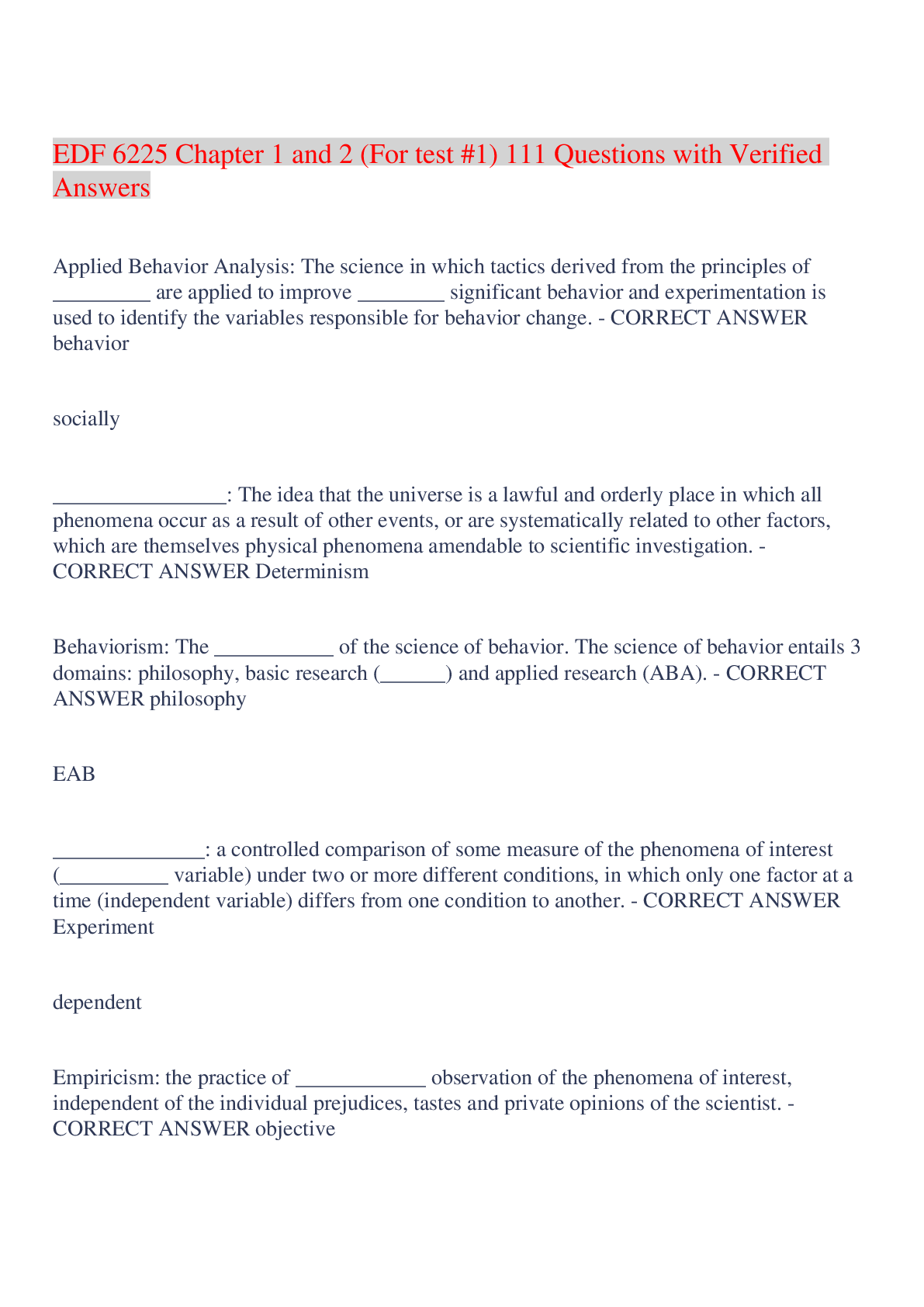
Buy this document to get the full access instantly
Instant Download Access after purchase
Add to cartInstant download
Reviews( 0 )
Document information
Connected school, study & course
About the document
Uploaded On
Dec 25, 2023
Number of pages
17
Written in
Additional information
This document has been written for:
Uploaded
Dec 25, 2023
Downloads
0
Views
19













